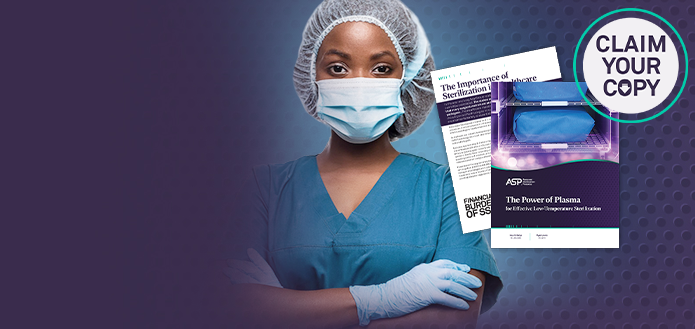As a leader in infection prevention and sterile processing solutions, ASP understands the critical importance of regulatory standards for both patient safety and staff protection. The recent 2024 revision of the ANSI/AAMI ST58 standard sets a new benchmark in chemical sterilization and high-level disinfection (HLD) practices. Whether you’re a Sterile Processing Department (SPD) professional or an infection preventionist, staying informed and compliant is essential. Here’s what’s new, why it matters, and how ASP products and expertise can help SPDs effortlessly meet the updated requirements.

The 2024 AAMI ST58 Update: What Sterile Processing and Infection Prevention Professionals Need to Know
Why the 2024 AAMI ST58 Standard Matters
The 2024 update to AAMI ST58 is a comprehensive overhaul, reflecting advances in technology, greater awareness of occupational health, and new challenges in device complexity.1 It introduces stricter benchmarks for handling chemical sterilants, improved protocols for facility design and workflow, and new expectations for monitoring sterilization efficacy. The standard focuses on patient risk and places increased emphasis on the health and safety of SPD staff, aiming to minimize workplace exposure to hazardous chemicals.2
In addition to these updates, it’s important to note that AAMI ST58 continues to align with the widely accepted Spaulding classification system for device reprocessing. This means that for semi-critical devices, such as flexible endoscopes, sterilization is preferred over high-level disinfection when feasible and indicated in the manufacturer’s Instructions For Use (IFU). ST58 places this guidance under its general considerations for cleaning, underscoring the principle that sterilization offers the highest margin of safety when available. The STERRAD™ 100NX with ALLClear™ Technology features the ULTRA GI™ cycle—the first FDA-cleared low-temperature sterilization cycle for H2O2-compatible duodenoscopes—giving healthcare facilities a practical way to follow this recommendation and strengthen infection prevention practices.
Five Key Changes in AAMI ST58:20245.4.1
1. Enhanced Room Ventilation and Air Quality
What’s new:
The standard recommends a minimum of 10 air exchanges per hour in areas where chemical sterilants and HLD are used, with a preference for localized exhaust ventilation at the point of vapor release. Vapor monitoring is recommended if there is potential for the hydrogen peroxide vapor concentration to exceed OSHA recommended permissible exposure limits (PEL), which can occur in the event of a sterilizer failure. The standard states that facility managers should conduct environmental monitoring and respond to any variances with a multidisciplinary risk assessment.2
How we help:
Advanced low-temperature sterilizers like STERRAD™ Sterilizers with ALLClear™ Technology are compatible with modern ventilation requirements. They use hydrogen peroxide gas plasma (HPGP) technology to reduce hydrogen peroxide emissions that are well below the American Conference of Governmental Industrial Hygienists (ACGIH®) Threshold Limit Value, further protecting workers.3
The proprietary technology used in STERRAD Sterilizers diffuses hydrogen peroxide vapor into the sterilizer chamber and then electromagnetically excites the hydrogen peroxide molecules into a low-temperature plasma state. The combined use of hydrogen peroxide vapor and plasma safely and rapidly sterilizes medical instruments and materials without leaving toxic residue or producing harmful emissions, based on OSHA detection limits.
2. Improved Drying and Disinfection Protocols
What’s new:
Adherence to strict moisture control protocols before low-temperature or gaseous sterilization is necessary. Excess moisture can cause cycle failures or reduce efficacy. An example of this can occur when too much moisture evaporates. air is being removed, causing some areas of the load to become cold. Sterilant may then condense and can lead to the cycle being canceled and the monitoring results failing. The standard emphasizes following manufacturers’ instructions for drying and requires verified processes for excess moisture removal.2
How we help:
ALLClear Technology, included with every new STERRAD Sterilizer, provides moisture detection and correction, when possible, for optimal drying and pre-conditioning of loads, reducing risks of failed cycles or chemical exposure. This functionality occurs at the beginning of the cycle to help maximize efficiency and reduce wasted sterilant.
3. Optimized Loading Practices for Vaporized Hydrogen Peroxide (VH₂O₂)
Sterilizers
What’s new:
SPD teams must strictly adhere to manufacturer instructions for use (IFUs) and proper chamber loading. The new guidelines discourage overloading, require clear documentation, and encourage technologies that minimize emissions during cancelled or aborted cycles.2
How we help:
STERRAD Sterilizers have an intuitive, user-friendly interface that walks users through cycle information and sterilizer operation. Additionally, ALLClear Technology proactively checks for load suitability and excess moisture, helping to reduce user error and unnecessary cycle cancellations.
4. Upgraded Chemical Indicator Requirements
What’s new:
The standard now recommends Type 4 chemical indicators for internal monitoring in terminal sterilization, replacing the less-informative Type 1 indicator.2 This change enables the monitoring of two or more parameters to gain a better understanding of the sterilization effectiveness. Type 4 chemical indicators respond to multiple critical parameters, providing better assurance of sterilization efficacy.
How we help:
Our VERISURE™ VH₂O₂ Type 4 Multi-Variable CI Strips meet the new recommendation, enabling SPD teams to validate every cycle with confidence.
5. Comprehensive Training and Documentation
What’s new:
AAMI ST58:2024 places greater emphasis on evaluating sterilants and disinfectants based on toxicity, exposure routes, and occupational safety regulations.2 Hydrogen peroxide emissions can vary widely due to factors like sterilizer age, maintenance, operator error, and engineering controls. Regular preventive maintenance and use of OEM service and parts are critical to maintaining system performance, reducing emissions, and ensuring compliance.
The updated standard also prescribes more rigorous, documented training and annual competency validation for SPD staff involved in chemical sterilization or HLD reprocessing. It stresses the necessity of Standard Operating Procedures (SOPs) for cleaning, environmental hygiene, emergency response, and record-keeping for audits.2
How we help:
ASP works hand-in-hand with our customers to provide onsite, detailed training, and in-services to ensure every SPD team member is confident and comfortable in using our products in a compliant manner. Our team of highly experienced clinical education consultants (CECs) regularly visit customers and assist with answering questions and helping to on board new SPD staff to increase their knowledge of and confidence in using ASP products to help maximize the efficiency of the department. The CEC team offers a variety of continuing education programs to help SPD staff to maintain their certification as recommended by AAMI.
SPDs can feel confident that their ASP systems, when using OEM service and parts, are operating optimally to reduce downtime, cancellations, and harmful emissions. Our technicians receive comprehensive training and use specially calibrated tools to keep ASP equipment running efficiently.
How We Keep Your Facility Audit Ready for AAMI ST58:2024
We understand that navigating regulatory changes can feel overwhelming. That’s why our products are engineered for compliance, and our team of ASP-trained technicians and clinicians are ready to guide you at every step:
- Product Compatibility: STERRAD Sterilizers meet or exceed AAMI ST58:2024 requirements for safety, efficacy, and emission control.
- OEM Parts and Service: Our certified technicians use only OEM parts, ensuring system integrity, minimal downtime, and compliance with regulatory maintenance guidelines.
- Exposure Reduction: STERRAD Sterilizers use proprietary technology that reduces environmental concentrations of hydrogen peroxide to less than or equal to 0.3 ppm, minimizing healthcare worker chemical exposure.
- Expert Training: From onboarding to in services to continuing education, we deliver hands-on training by clinical experts, enabling SPD teams to satisfy the new documentation requirements and certification recommendations.
Why Trust ASP As Your AAMI ST58 Partner?
The 2024 update to ANSI/AAMI ST58 represents a pivotal step forward in safeguarding both patients and healthcare workers. By adopting these enhanced guidelines, healthcare facilities can improve sterilization quality, reduce hazardous emissions, and create safer working environments for SPD staff. Investing in advanced sterilization technologies, rigorous training, and regular equipment maintenance provided by the manufacturer aligns with these new standards.
With decades of experience, a multidisciplinary team that stays abreast of regulatory changes, and a robust suite of products designed to elevate the standard of care and margin of safety, ASP is your long-term partner and trusted advisor. When you invest in our sterilization solutions, you’re building a safe, efficient, and resilient sterile processing environment that protects your staff and your patients.
Stay safe. Stay compliant. Trust the experts at ASP.
References
Visnovsky, D. (2024, October 28). “Major Overhaul” for AAMI Guidance on EO, Other Chemical Modalities in Hospitals. AAMIARRAY. https://array.aami.org/content/news/aami-update-ethylene-oxide-hospital-chemical-sterilization
ANSI/AAMI ST58:2024. Chemical sterilization and high level disinfection in health care facilities.
Actionable Research and ChemDAQ™ Inc, 2016. STERRAD™ 100NX, STERRAD NX™, V-PRO™ 1 Plus and V-PRO™ maX Hydrogen Peroxide Emissions Testing. Research sponsored by ASP.
Reach out to us for more information about ASP Solutions.
We’re Hiring!
ASP is looking for you to join our team of innovative thinkers, who are customer obsessed, courageous and passionate about building extraordinary teams. View our hiring opportunities and help us to elevate the standard of care for patients globally. Join us!
We are ASP!
Authors/Contributors:

RN, BSN, CNOR, Clinical Education Consultant, ASP

Associate Marketing Communications Manager, ASP


